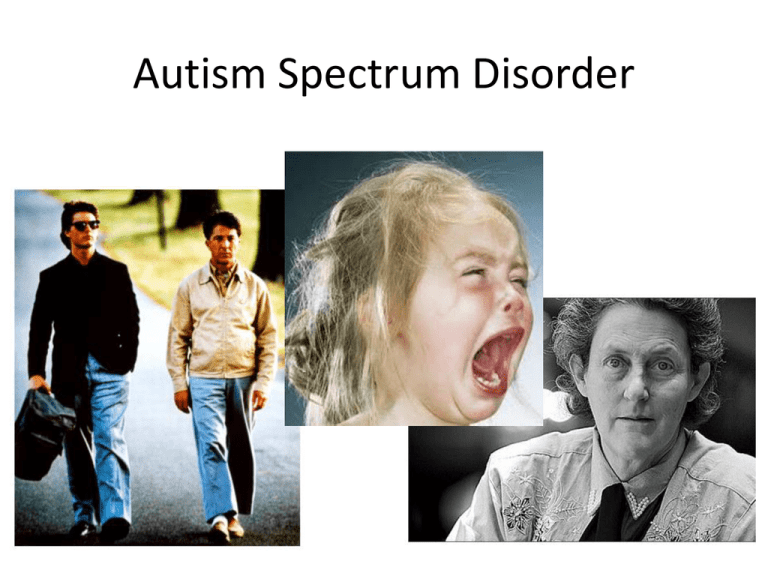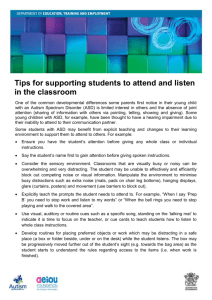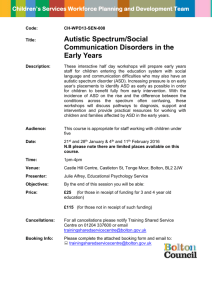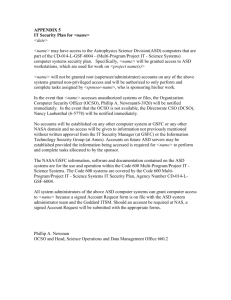Autism Presentation Cog Neuro
advertisement

Autism Spectrum Disorder
Background
Pervasive Developmental Disorder (PDD)
Deficits in social relatedness, communication and restricted interests/behaviours
Autism Spectrum Disorder (ASD)
ASD
{
Autistic Disorder
Asperger’s Disorder
Pervasive Developmental Disorder Not Otherwise Specified (PDD-NOS)
-Highly heritable
-3-4 males for every female
-1/110 estimated prevalence
Non-clinical
SPECTRUM
Severe
Domains of Impairment in ASD
Domain
Autism
Asperger's
PDD-NOS
ASD
social communication
required
required
required
language
required
repetitive, restrictive behaviours
required
required
variable
sensory abnormalities
>90%
80%
variable
94%
developmental regression
15-40%
?
?
15-40%
motor signs
60-80%
60%
60%
60-80%
gross motor delay
10%
?
?
5-10%
sleep disturbance
55%
5-10%
40%
50%
gastrointestinal disturbance
45%
4%
50%
4-50%
epilepsy
10-60%
0-5%
5-40%
6-60%
comorbid psychiatric diagnosis
70%
60%
>25%
25-70%
variable
Geschwind, Ann Rev Med (2009)
Comorbidity in ASD
Disorder
Depression
Generalized Anxiety Disorder
Social Phobia
Obsessive Compulsive Disorder
Panic Disorder
Agoraphobia
ADHD
Oppositional Defiant Disorder
Tics/Tourette's
Catatonia
%
19.6
14.3
10.7
3.6
3.6
3.6
16.1
10.7
1.8
1.8
Autism SPECTRUM Disorder
Social
Aloof
Prefers to be alone
Difficult to engage
Likes to interact
Wants friends
Doesn’t “get” social rules
Communication
Limited communication
Uses only physical means
Conversational language
One sided conversations
Restricted Activities/Interests
Sensory/Motoric
(e.g. spinning, tapping)
Routines/focused interests
(e.g. obsession with calendars)
Brain Size
Accelerated rates of brain growth
during early development
Result:
An increase in the ratio of
local relative to long distance
connections
Areas most affected:
Frontal and Temporal Lobes
ASD: 3 stages of brain growth
overgrowth, arrest, decline
(Mraz et al. 2007)
Sensory Systems - Visual
Sensory abnormalities and/or sensory hypersensitivity in ASD
Documentation of both superior and inferior sensory processing
+
C
C
-visual acuity expressed in the form 20:x
-average vision is 20:20 or the detail that
one can see from 20 feet away
C
Freiburg Visual Acuity and Contrast Test
-gaps 0.4 mm to 25 mm
-use arrow keys to indicate location of gap
C
Ashwin et al. (2009)
Sensory Systems – Visual
Results:
-ASD group 2.79 times better than average
-Visual Acuity Controls: 20:13
-Visual Acuity ASD: 20:7
AVG = 2.79
ASD group can see detail of an object
20 feet away as a person with average
vision would see from 7 feet away!
AVG = 1.44
(Ashwin et al. 2009)
ASD visual acuity approximates that
of birds of prey.
Sensory Systems - Auditory
Increased perception of loudness in ASD
Also …
People with ASD have
normal to superior
performance in pitch
discrimination and
music abilities
(Khalfa et al. 2004)
Sensory Systems
Theories?
-Abnormalities in the integration of parts and wholes
-Local range over-connectivity
-Sensory hypersensitivity
-could affect information processing that could cause distress
but could also predispose to unusual talent
Savantism
-a subgroup of those with ASD with
profound expertise or ability
-more prevalent in ASD than any other
neurological group
The Extreme Male Brain Theory
Recall the mental rotation task:
Females good at empathizing
Males good at systemizing
Men out preform women on
tasks requiring systemizing
e.g. visuospatial tasks
ASD group preformed better
overall as compared to controls
ASD brain believed to be an
exaggerated form of the male
brain
(Falter et al. 2008)
Face Processing
Pierce et al. 2001
Face Perception Task
Fusiform gyrus, superior temporal sulcus and amygdala activation in controls.
Lack of this activation in the ASD group.
Conclusion: Face processing occurs outside the FFA in ASD
Face Processing
Pierce et al. 2004
Face Processing Task Amended
-used stranger AND familiar faces
Results:
With familiar faces, normal FFA
activity was found in the ASD group
ASD group showed similar network
activation to controls only to familiar
faces
Amygdala can be responsive in ASD in
the presence of stimuli that is of high
emotional value
Conclusion:
ASD related FFA dysfunction may reflect deficits
in systems that modulate the FFA rather than
the FFA itself.
Language
Language and communication deficits a core feature of ASD
Difficulties with:
Pragmatics – problems using language within a social context
Articulation - poor oro-motor control
Prosody – speaking with monotone or an exaggerated singing prosody
Semantics – difficulty understanding the meanings of words
Grammar – pronoun reversal; speaking in grammatical sentences
Echolalia: repetition of another person’s spoken words
Language
Broca’s Area: production of speech
Volumetric Analysis of Broca’s area
Reversed asymmetry of Broca’s area
(R>L) in language-impaired ASD and
those with a specific language impairment
Symmetry reversal of Broca’s Area
is more closely related to a language
impairment than to a diagnosis of ASD
(Fosse et al. 2004)
Language
Harris et al. 2006
Semantic Processing Task
-Subjects indicated whether a word was +/- (Semantic) or whether a word was in
upper/lower case (Perceptual)
Results
Reduced Broca’s area activation for ASD group during semantic processing
Conclusion
Autism…. It is complex and complicated
Just trying to put the puzzle together one piece at a time!








